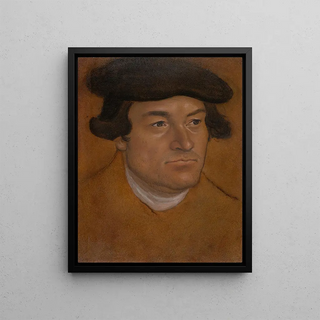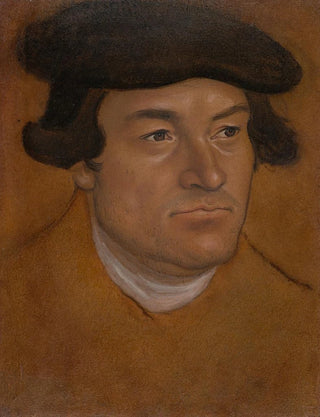Art print | Portrait of a man - Lucas Cranach the Elder


View from behind

Frame (optional)
In the vast panorama of the German Renaissance, the "Portrait of a Man" by Lucas Cranach the Elder stands out for its elegance and psychological depth. This artwork, created in the early 16th century, embodies not only the exceptional talent of its creator but also the aesthetic and intellectual concerns of its time. The face of the protagonist, imbued with serene gravity, immediately draws the eye, inviting the observer to delve into a universe where realism and symbolism blend harmoniously. This art print of "Portrait of a Man" by Lucas Cranach the Elder allows for rediscovering a masterpiece that continues to inspire and provoke thought.
Style and uniqueness of the work
The style of Lucas Cranach the Elder is characterized by a remarkable mastery of color and light, as well as meticulous attention to detail. In this portrait, the nuances of the skin, carefully rendered, seem almost alive, while the neutral background highlights the subject without distraction. The penetrating gaze of the painted man, combined with a slightly tilted posture, creates an atmosphere of mystery and introspection. Cranach plays with textures, whether in the rendering of hair or clothing, to give a striking sense of realism. This portrait is not only a physical representation but also an exploration of the human soul, a reflection of the values and aspirations of the Renaissance.
The artist and his influence
Lucas Cranach the Elder, born in 1472, is an emblematic figure of Northern art. His work is set against a backdrop of cultural and religious upheavals, marked by the Protestant Reformation. As a close associate of Martin Luther, Cranach was able to combine his spiritual commitment with his art, producing works that resonate with the ideals of his time. His portraits, often laden with symbolism, testify to a deep understanding of human psychology. Furthermore, his style has influenced many contemporary and later artists, making him a pillar of German painting. His ability to capture the essence of his subjects continues to inspire generations of artists.
An exceptional wall decoration signed Artem Legrand

Matte finish

View from behind

Frame (optional)
In the vast panorama of the German Renaissance, the "Portrait of a Man" by Lucas Cranach the Elder stands out for its elegance and psychological depth. This artwork, created in the early 16th century, embodies not only the exceptional talent of its creator but also the aesthetic and intellectual concerns of its time. The face of the protagonist, imbued with serene gravity, immediately draws the eye, inviting the observer to delve into a universe where realism and symbolism blend harmoniously. This art print of "Portrait of a Man" by Lucas Cranach the Elder allows for rediscovering a masterpiece that continues to inspire and provoke thought.
Style and uniqueness of the work
The style of Lucas Cranach the Elder is characterized by a remarkable mastery of color and light, as well as meticulous attention to detail. In this portrait, the nuances of the skin, carefully rendered, seem almost alive, while the neutral background highlights the subject without distraction. The penetrating gaze of the painted man, combined with a slightly tilted posture, creates an atmosphere of mystery and introspection. Cranach plays with textures, whether in the rendering of hair or clothing, to give a striking sense of realism. This portrait is not only a physical representation but also an exploration of the human soul, a reflection of the values and aspirations of the Renaissance.
The artist and his influence
Lucas Cranach the Elder, born in 1472, is an emblematic figure of Northern art. His work is set against a backdrop of cultural and religious upheavals, marked by the Protestant Reformation. As a close associate of Martin Luther, Cranach was able to combine his spiritual commitment with his art, producing works that resonate with the ideals of his time. His portraits, often laden with symbolism, testify to a deep understanding of human psychology. Furthermore, his style has influenced many contemporary and later artists, making him a pillar of German painting. His ability to capture the essence of his subjects continues to inspire generations of artists.
An exceptional wall decoration signed Artem Legrand






